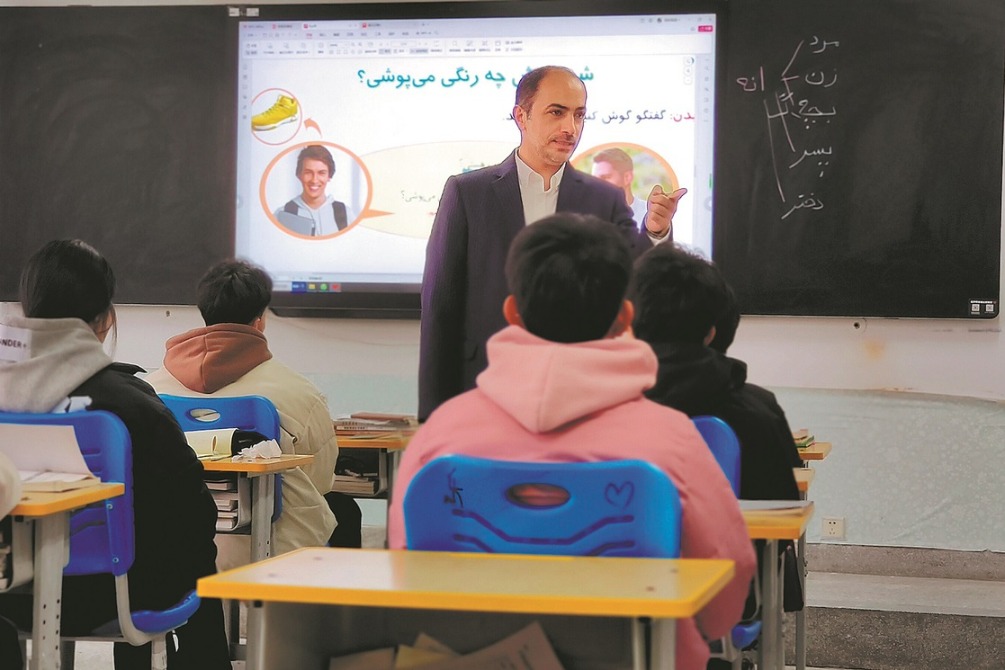Utah leads US in pre-college Chinese language studies
By LINDA DENG in Salt Lake City, Utah | China Daily Global | Updated: 2019-06-10 22:51
When members of a Chinese delegation visiting Utah recently walked into a classroom at Alpine Elementary School, they were amazed at how many US students were speaking not only fluent Chinese but also showing great interest in Chinese culture.
The pupils were asked why they wanted to learn Mandarin.
Some of the responses were: "China has many people, I can make friends in China."
"If there is a job that asks for the ability to speak Chinese, I can get that job."
The delegation was in Utah last month to attend the Golden Spike 150th anniversary celebrating the completion of the Transcontinental Railroad. Chinese laborers played a vital role in the construction, which was finished on May 10, 1869.
The visitors were surprised that Utah, The Beehive State, is a national leader in implementing an English and Chinese dual-language immersion program and has more K12 students studying Chinese than any other state in the country.
Utah has only 1 percent of the nation's population, but 25 percent of Chinese dual-language immersion students in the United States. In the past decade, the sparsely populated state of 3.1 million has successfully integrated the Chinese language into its public curriculum.
Now 13,000 Utah K12 students are learning Mandarin, and the program runs in 12 school districts at 38 public and private schools and one charter school.
Howard Stephenson, a former state senator and an advocate for dual-language immersion, said "monolingualism is the illiteracy of the 21st century".
"In Utah, even though the parents and grandparents don't understand what their kids are talking about, they still tend to let their kids learn Chinese," Stephenson said.
Stephenson went to Beijing 19 years ago to speak at a conference. What he discovered was that among the 1,000 college students at the event, including those from Russia, the US and China, only the Chinese were bilingual.
"I wanted that for US students, too," he said. "In order to compete and cooperate with China, I knew our people needed to be bilingual," he recalled.
Chinese tourists bring more than $140 million into Utah's economy each year.
Stephenson sees that opportunity and has been working with the superintendents of the five national parks in Utah to make sure dual-language immersion students can work in the visitor centers and on the buses with Chinese tourists during the summer.
Jeff Hartley, a businessman in Salt Lake City, plans to go on a business trip to China this summer. Both of his daughters, ages 12 and 8, now speak fluent Chinese. They have been studying Chinese since the first grade, and their school is half-day English, half-day Chinese.
"The future economic growth has to involve China, in a bigger and bigger way," said Hartley, adding that his daughters will have more opportunities because they speak Chinese.
In 2008, the Utah Senate passed the International Initiatives bill creating funding for schools to begin dual-language immersion programs in Chinese, French and Spanish. In addition, then-governor Jon Huntsman Jr. initiated the Governor's Language Summit and the Governor's World Language Council. A Mandarin speaker, Huntsman served as US ambassador to China from 2009 to 2011.
In 2010, current Governor Gary Herbert and state Superintendent of Public Instruction Larry Shumway issued a challenge to Utah educators to implement 100 dual-language immersion programs throughout the state by 2015, with the goal of enrolling 30,000 students.
Thanks to the early success of the program and public demand, the governor and superintendent moved the target completion date to 2014, with a continuing goal to mainstream dual-language immersion programs throughout the Utah public school system.
So far, Spanish has the most applicants, with Mandarin being second.
At the Alpine Elementary School, which has the Utah Chinese Dual Language Immersion Program, teachers use a 50/50 model: pupils in grades K6 spend half of their school day studying in English and the other half in Chinese.
"Our program grew very quickly, starting with 6 elementary schools and jumping to about 24 in the first 4 years. We have temporarily 'frozen' our elementary growth at 32 schools, as we are still expanding into secondary schools. For the next school year we will have 41 secondary schools in the program, for a total of 73 schools in 13 districts. Once we have built out the entire K-12 pipeline in two more years, we will look at allowing more elementary schools in at the base level. As it stands now, most schools have waiting lists. "said Stacy Lyon, the Utah Chinese Dual Language Immersion director.
"This is an indication of the high level of interest our local communities have in their children learning Chinese. Parents believe it is the most critical language of the future in terms of employment, and will be an invaluable benefit to their child's professional opportunities. "Lyon added.
To find qualified Chinese teachers, the state uses multiple sources, including interviewing teachers in China.
























